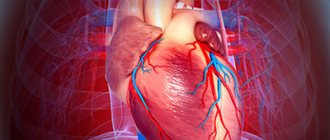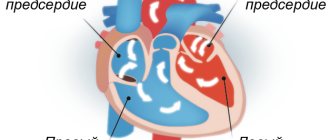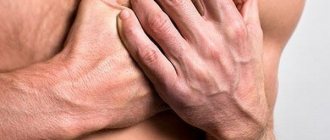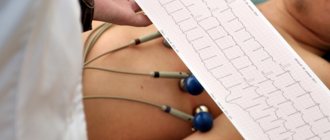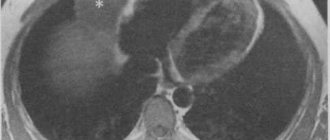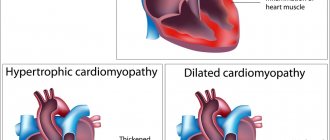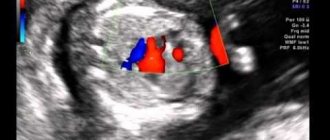Read in this article:
- Why does the heart rate slow down?
- Causes of decreased heart rate
- Types of bradycardia
- Symptoms of low heart rate
- Diagnostic measures
- Actions when your heart rate is low
- Prevention of bradycardia
- Bradycardia can be dangerous
Pulse is considered one of the main biomarkers of the human body. This indicator allows you to assess the condition of the body and the quality of the cardiovascular system. A heart rhythm disorder in which the heart rate slows down is called tachycardia.
Why does the heart rate slow down?
Bradycardia - what is it from a physiological point of view? When the heart beats, its two atria contract first, sending blood into the ventricles. The two ventricles then contract, resulting in blood being pumped into the aorta. From this large vessel it spreads to all tissues and organs.
A special conduction system is responsible for the contractions of the heart. Its work is regulated by the sinus node, located in the wall of the right atrium. It is what slows down the heart rate when a person sleeps and increases it during physical activity. From the sinus node, the impulse is transmitted to the atria, causing them to contract, and then to the ventricles. A decrease in heart rate occurs due to failures at one of these stages.
Risk factors for developing cardiac arrhythmia
Risk factors for developing cardiac arrhythmias include:
- ✔ Genetics.
In people with congenital abnormalities of the heart, arrhythmias occur more often. Moreover, a number of arrhythmias (eg, Wolff-Parkinson-White syndrome, some supraventricular tachycardias, some forms of long QT syndrome) are congenital. - ✔ Thyroid diseases.
With increased thyroid function, increased production of hormones occurs, overall metabolism increases, and heart contractions become more frequent and irregular. Atrial fibrillation most often develops. With insufficient thyroid function, metabolism decreases, which causes bradycardia, and in some cases, extrasystole. - ✔ High blood pressure.
This increases the risk of developing coronary heart disease. High blood pressure also causes the wall of the left ventricle to thicken, which can change the way impulses are conducted through it. - ✔ Diabetes mellitus.
Diabetes mellitus in the stage of decompensation (uncontrolled blood sugar levels) greatly increases the risk of developing coronary heart disease and arterial hypertension. In addition, episodes of hypoglycemia (low blood sugar) can be a trigger for the development of cardiac arrhythmias. - ✔ Electrolyte disturbances.
Electrolytes such as potassium, magnesium, sodium and calcium form the basis for the formation, maintenance and conduction of electrical impulses in the heart. Too high or too low concentrations of electrolytes in the blood and in heart cells affect the electrical activity of the heart and can cause the development of arrhythmias. - ✔ Use of stimulants.
Psychostimulants such as caffeine, nicotine, etc. cause the development of extrasystole and can also lead to the development of more severe heart rhythm disturbances over time. The use of amphetamines and cocaine can damage the heart muscle with the development of any of the existing arrhythmias and even lead to sudden cardiac death due to the development of ventricular fibrillation.
Causes of decreased heart rate
The lower limit of normal heart rate is 60 beats per minute. If the indicator falls below this value, this is usually associated with pathological conditions. Low heart rate can only be considered normal for trained athletes.
In other cases, the causes of decreased heart rate are divided into several groups:
- Extracardiac – diseases not related to the work of the heart;
- Organic – arising against the background of cardiac pathologies;
- Toxicological – caused by intoxication of the body;
- Physiological.
One of the most common causes of slow heart rate is a disturbance in the production of impulses in the sinus node. This happens with myocardial infarction and myocarditis (inflammation of the heart muscle), poisoning and hormonal imbalance. In this case we are talking about sinus bradycardia.
Noncardiac causes of low heart rate include cardiac ischemia, cardiomyopathy, heart failure, and heart defects, both acquired and congenital. Other diseases that cause such manifestations include:
- Severe infections, such as meningitis or diphtheria, typhoid fever or hepatitis;
- Anemia;
- Pathologies of the endocrine glands - diabetes, dysfunction of the adrenal glands or thyroid gland;
- Vegetovascular dystonia;
- Respiratory diseases - asthma, bronchitis.
Toxicological factors can lead to low heart rate. These include uncontrolled use of medications, such as heart stimulants or diuretics. The same applies to the use of alcohol and drugs, smoking, and any acute intoxication of the body. The pulse may decrease due to a lack or excess of sodium, magnesium, potassium, and calcium ions in the body.
As for physiological factors that can cause a slower heart rate, these include prolonged exposure to low temperatures, hormonal changes in adolescents, general fatigue of the body, and slower metabolism in older people.
Rapid heartbeat in a child
Children have a higher heart rate than adults. Moreover, the younger the child, the faster his heart beats. Typically, palpitations in children have the following causes:
- fear, joy, stressful situation;
- exercise stress;
- cardiac and non-cardiac diseases;
- weather change.
If the increase in heart rate is associated with emotional or physical stress, then it will normalize on its own.
But tachycardia is not always harmless. It may be a sign of a serious illness, for example, heart failure, arrhythmia, myocarditis.
The child may experience acute attacks of rapid heartbeat, which are called paroxysmal tachycardia. Sometimes they last for several hours and are accompanied by dizziness, nausea, chest pain, convulsions, cold sweat, and fainting.
A child with tachycardia experiences fear and has difficulty breathing. He needs to be calmed down and an ambulance quickly called.
Types of bradycardia
There are several types of bradycardia:
- Absolute – with a steadily reduced heart rate, which does not increase even with physical activity;
- Relative – the pulse increases in proportion to the degree of load or against the background of infectious diseases;
- Moderate - at rest, the pulse does not exceed 40 beats per minute.
Even if a decrease in heart rate does not bother a person or cause any discomfort, it is necessary to identify the cause of such changes in order to prevent the risk of dangerous complications.
Tachycardia in pregnant women
During pregnancy, significant changes occur in a woman’s body and it begins to work in a different mode. Rapid heartbeat (up to 100 beats per minute or higher) is normal during this period. Often, tachycardia during pregnancy is mild and does not pose a danger. But it happens that it is accompanied by unpleasant symptoms:
- headaches;
- dizziness;
- chest pain;
- sometimes fainting.
Doctors recommend that the expectant mother:
- rest more;
- avoid stress;
- drink more clean water.
If palpitations bother a woman during pregnancy, she should consult a cardiologist.
Symptoms of low heart rate
Low heart rate symptoms are signs that accompany a slow heart rate:
- Semi-fainting or fainting states;
- Difficulty breathing;
- Dizziness and weakness;
- Chest tenderness;
- Blood pressure surges;
- Periodic short-term visual disturbances;
- Impaired concentration, memory function;
- Headache;
- Confusion of creation;
- Numbness of the extremities, feeling of coldness in the arms and legs.
With a moderate decrease in heart rate (5-10% of normal), bradycardia may not manifest itself in any way. Symptoms generally appear with a more significant drop in readings.
Palpitations and increased blood pressure
Tachycardia is often characterized not only by rapid heartbeat, but also by hypertension. If you have high blood pressure during an attack, you need to take the following measures:
- Sit or lie down comfortably and try to completely relax.
- Drink some cold water. As it passes through the esophagus, it puts pressure on the heart, thereby normalizing its function.
- Sometimes washing with cold water can help.
- Another way to lower your heart rate if your blood pressure is high is to take a deep breath, cover your nose and mouth with your hand, and try to exhale.
- If the cause of the attack is stress, relaxation, aromatherapy and meditation will help.
- With pronounced palpitations, doctors advise taking anaprilin.
- The menu should include more seafood and fish, which are rich in omega-3 fatty acids.
- Vitamin complexes should be taken by those who have tachycardia with high blood pressure caused by a lack of magnesium in the body.
During an attack of tachycardia, you need to take a comfortable position and relax
Diagnostic measures
In order to diagnose bradycardia, the general clinical picture is studied: a person’s lifestyle, his complaints, and accompanying symptoms. A cardiac examination is required to identify possible heart pathologies. The doctor analyzes information about the medications the person is taking and compares the electrocardiogram data with other indicators obtained as a result of laboratory tests and examinations. The classic Holter method or weekly monitoring of the heart rhythm using a special mobile device can be used.
Diagnostics
Based on the symptoms and collection of anamnesis (patient complaints), one can suspect the cause of tachycardia. To make an accurate diagnosis, the doctor will prescribe special examinations: an electrocardiogram (ECG), ultrasound of the heart (ECHOCARDIOGRAPHY), general blood test, urine test, blood test for hormones.
Currently, it is possible to monitor the work of a patient’s heart in the normal rhythm of life. Using a portable device, which is attached to the belt under clothing, an ECG is continuously recorded throughout the day. This procedure is called 24-hour Holter ECG monitoring. It can be done in the hospital and at home.
Actions when your heart rate is low
Bradycardia can be dangerous, because with rare contractions of the myocardium and slow blood circulation, hypoxia develops. Oxygen starvation has an extremely negative effect on the brain and causes loss of consciousness. If a person is not given prompt assistance, breathing may stop. This is why it is important to know exactly what to do when your heart rate is low.
Help with a decrease in heart rate depends on the reasons that cause it. If we are not talking about heart disease, you can cope with the problem on your own:
- Take Corvalol;
- Drink 20 drops of motherwort twice a day;
- Take Zelenin drops until the pulse is completely restored (the drug has contraindications: organic damage to the heart, pancreas, vision).
If the pulse decreases due to heart disease or other pathologies, you must call an ambulance. Before the doctor arrives, the person must be positioned so that the legs are higher than the heart. For breast tenderness, you can give nitroglycerin, a fast-acting drug that provides relief in just 5 minutes. Belladonna extract can help with the first attacks of bradycardia, but its effect takes about half an hour.
Treatment methods
Rapid night heartbeat is treated depending on the cause that provoked it. To rid a person of unpleasant symptoms, medications and folk remedies are used.
Tachycardia at night is eliminated:
- Sedatives. They practice the use of drugs based on medicinal plants in the form of infusions of motherwort and valerian, Novo-passit. They are produced in the form of drops, tablets, and infusions.
- Antiarrhythmic drugs. These tablets are designed to normalize the heartbeat. They have a number of contraindications, so the attending physician must select the medicine.
Tachycardia is also eliminated with cardiac glucosides, beta blockers, antioxidants, and sedatives.
- Drugs for rapid heartbeat: effective remedies for tachycardia
You should get rid of strong heartbeat at home with the help of mint, lemon balm, St. John's wort, chamomile, motherwort and others. An infusion is prepared from these plants. An effective remedy for tachycardia is a decoction of valerian root, yarrow and lemon balm.
Take a teaspoon of all components, add boiled water and simmer in a water bath for 40 minutes. Then cool, filter and drink.
If tachycardia bothers you at night, experts recommend adjusting your lifestyle. It is important to avoid stress and excessive loads. It is necessary to ensure that a sufficient amount of vitamins enters the body. Omega-3s are of great benefit to the body. These acids are found in fish.
In the evening before going to bed, you should not think about your problems. Since sometimes the heart rate increases under the influence of medications, it is necessary not to take them in the evening and report this adverse reaction to your doctor.
Prevention of bradycardia
In order to prevent bradycardia, it is necessary to undergo regular medical examinations, and if you have heart disease, follow all doctor’s recommendations. In such cases, it is very important to systematically measure blood pressure and report significant changes to the doctor. By the way, home automatic blood pressure monitors determine not only upper and lower pressure, but also pulse rate, and also record arrhythmia.
A healthy lifestyle helps to avoid the development of bradycardia: an optimal combination of work and rest, proper nutrition, regular physical activity appropriate for age and health.
The doctor will help you in the future
The doctor must decide what to do next. Be sure to consult a doctor. The sooner first aid is provided and the cause of the disease is determined, the more effective the treatment process will be. The main task is to find and eliminate the cause of tachycardia.
Only a doctor can make a correct diagnosis, prescribe medications if necessary, and, if necessary, recommend surgical treatment.
For any form of tachycardia, the treatment complex includes physical therapy (physical therapy), dietary, balanced nutrition, dosed walking, proper sleep, and elimination of factors causing the disease. It is definitely recommended to give up bad habits, not self-medicate and lead a healthy lifestyle.
